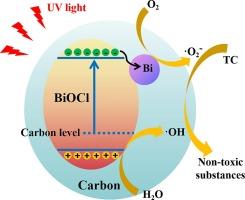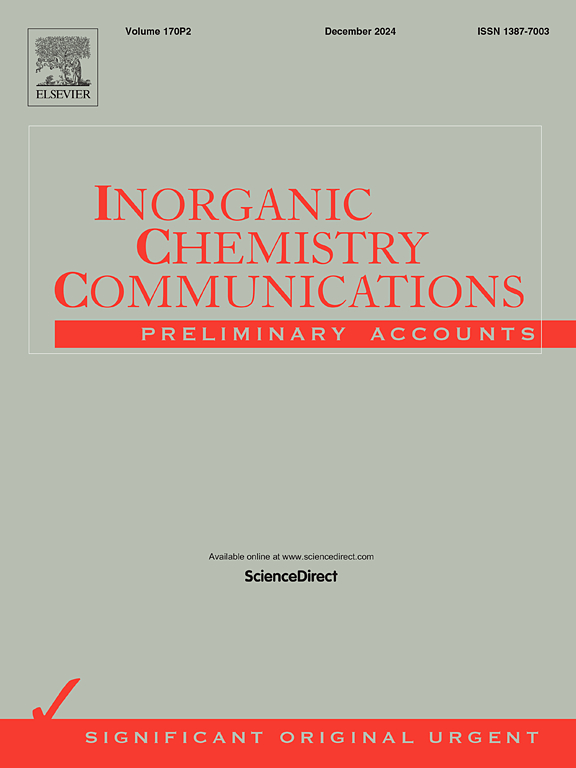由 Bi-MOF 衍生的新型 BiOCl@Bi-carbon 异质结可作为高效、可回收的光催化剂降解四环素
IF 4.4
3区 化学
Q1 CHEMISTRY, INORGANIC & NUCLEAR
引用次数: 0
摘要
抗生素,尤其是四环素(TC),由于其抑菌和抗菌特性,被广泛用于医药、农业、畜牧业和食品工业。然而,抗生素的广泛使用导致了严重的后果,尤其是水污染和大量抗生素耐药微生物的出现。因此,必须采取有效措施来减轻这些环境影响。本文介绍了一种由 Bi-MOF 衍生的新型 BiOCl@Bi-carbon 异质结。通过各种技术对合成样品进行了全面表征。结果表明,BiOCl 通过原位转化在 Bi-MOF 表面成功合成,Bi-MOF 经过高温退火处理后转化为掺铒多孔碳(Bi-碳)。BiOCl 与 Bi-carbon 的耦合大大提高了光电流密度。通过测定三氯甲烷的降解率,有效评估了样品的光催化活性,其中 BiOCl@Bi-carbon 的光催化效率最高,对三氯甲烷的降解率达到 96.27%。此外,BiOCl@Bi-碳还具有出色的稳定性。其出色的光催化性能表明它具有巨大的实际应用潜力。此外,我们还在研究的最后分析了 TC 的光催化降解机理。本文章由计算机程序翻译,如有差异,请以英文原文为准。

A novel BiOCl@Bi-carbon heterojunction derived from Bi-MOF as an efficient and recyclable photocatalyst for degradation of tetracycline
Antibiotics, particularly tetracycline (TC), are extensively used in medicine, agriculture, animal husbandry, and the food industry due to their bacteriostatic and antibacterial properties. However, the widespread use of antibiotics has led to serious consequences, particularly in the form of water pollution and the emergence of numerous antibiotic-resistant microorganisms. Therefore, it is essential to implement effective measures to mitigate these environmental impacts. In this paper, we introduce a novel BiOCl@Bi-carbon heterojunction derived from Bi-MOF. The synthesized samples were thoroughly characterized through various techniques. The results demonstrate that BiOCl was successfully synthesized on the surface of Bi-MOF via in situ transformation, and that Bi-MOF was converted into Bi-doped porous carbon (Bi-carbon) after high-temperature annealing treatment. The coupling of BiOCl with Bi-carbon significantly enhances the photocurrent density. The photocatalytic activity of the samples was effectively evaluated by measuring the degradation of TC, with BiOCl@Bi-carbon demonstrating the highest photocatalytic efficiency, achieving a degradation rate of 96.27 % for TC. Additionally, BiOCl@Bi-carbon exhibits excellent stability. Its outstanding photocatalytic performance indicates significant potential for practical applications. Furthermore, we analyze the mechanism underlying the photocatalytic degradation of TC at the end of the study.
求助全文
通过发布文献求助,成功后即可免费获取论文全文。
去求助
来源期刊

Inorganic Chemistry Communications
化学-无机化学与核化学
CiteScore
5.50
自引率
7.90%
发文量
1013
审稿时长
53 days
期刊介绍:
Launched in January 1998, Inorganic Chemistry Communications is an international journal dedicated to the rapid publication of short communications in the major areas of inorganic, organometallic and supramolecular chemistry. Topics include synthetic and reaction chemistry, kinetics and mechanisms of reactions, bioinorganic chemistry, photochemistry and the use of metal and organometallic compounds in stoichiometric and catalytic synthesis or organic compounds.
 求助内容:
求助内容: 应助结果提醒方式:
应助结果提醒方式:


